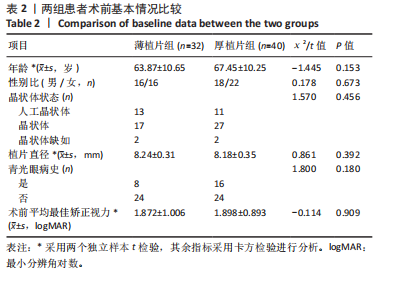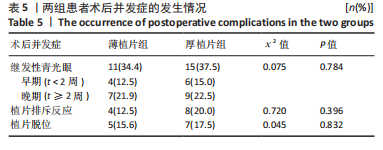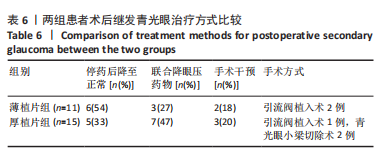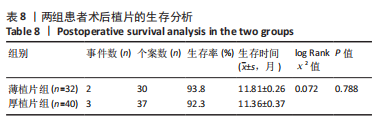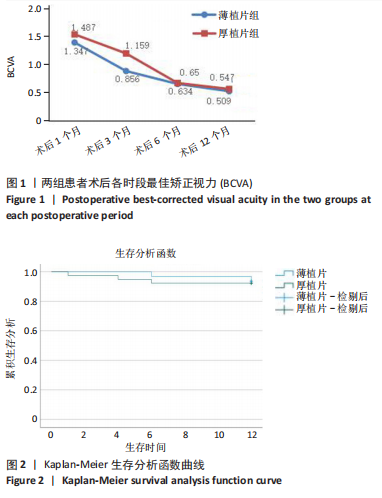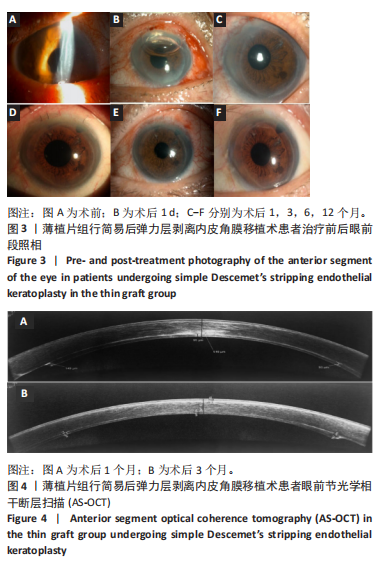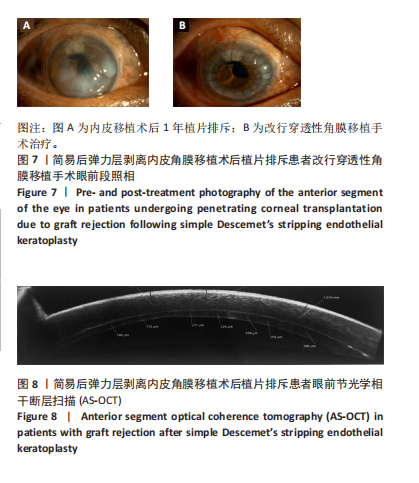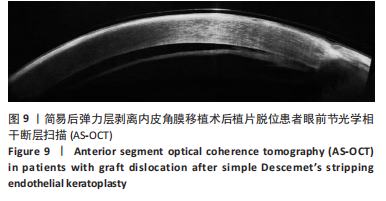[1] ONG HS, ANG M, MEHTA JS. Evolution of therapies for the corneal endothelium: past, present and future approaches. Br J Ophthalmol. 2021;105(4):454-467.
[2] VALLABH N A, KENNEDY S, VINCIGUERRA R, et al. Corneal Endothelial Cell Loss in Glaucoma and Glaucoma Surgery and the Utility of Management with Descemet Membrane Endothelial Keratoplasty (DMEK). J Ophthalmol. 2022;2022:1315299.
[3] ALI M, CHO K, SRIKUMARAN D. Fuchs Dystrophy and Cataract: Diagnosis, Evaluation and Treatment. Ophthalmol Ther. 2023;12(2):691-704.
[4] SINGH M, SINHA B P, MISHAR D, et al. Role of corneal collagen cross-linking in bullous keratopathy: A systematic review. Indian J Ophthalmol. 2023;71(5):1706-1717.
[5] TOURABALY M, CHETRIT Y, PROVOST J, et al. Influence of graft thickness and regularity on vision recovery after endothelial keratoplasty. Br J Ophthalmol.2020;104(9):1317-1323.
[6] ANG MJ, CHAMBRELAIN W, LIN CC, et al. Effect of Unilateral Endothelial Keratoplasty on Vision-Related Quality-of-Life Outcomes in the Descemet Endothelial Thickness Comparison Trial (DETECT): A Secondary Analysis of a Randomized Clinical Trial. JAMA Ophthalmol. 2019;137(7):747-754.
[7] BINESHFAR N, TAHVILDARI A, FEIZI S. Management of post-keratoplasty ametropia. Ther Adv Ophthalmol. 2023;15:25158414231204717.
[8] ADEMMER V, AGHA B, SHAJARI M, et al. Impact of DMEK on visual quality in patients with Fuchs’ endothelial dystrophy. Graefes Arch Clin Exp Ophthalmol.2022;260(2):521-528.
[9] GOLHAIT P, PESEYIE R.Persistent Epithelial Defect.2023//StatPearls [Internet].Treasure Island (FL): StatPearls Publishing.2024.
[10] 中华医学会眼科学分会角膜病学组.中国人工角膜移植手术专家共识(2021年)[J]. 中华眼科杂志,2021,57(10):727-733.
[11] SANDHU S, PETSOGLOU C, GRIGG J, et al. Elevated Intraocular Pressure in Patients Undergoing Penetrating Keratoplasty and Descemet Stripping Endothelial Keratoplasty. J Glaucoma. 2016;25(4):390-396.
[12] TILAK A, DORA J, TUDU KC, et al. A Comprehensive Investigation Into the Outcomes of Descemet’s Stripping Endothelial Keratoplasty (DSEK) as a Treatment for Corneal Endothelial Disorders. Cureus. 2023;15(9): e46076.
[13] GURNANI B, KAUR K, LALGUDI VG, et al. Risk Factors for Descemet Membrane Endothelial Keratoplasty Rejection: Current Perspectives- Systematic Review. Clin Ophthalmol. 2023;17:421-440.
[14] VIBERG A, SAMOLOV B, BYSTRÖM B. Descemet Stripping Automated Endothelial Keratoplasty versus Descemet Membrane Endothelial Keratoplasty for Fuchs Endothelial Corneal Dystrophy: A National Registry-Based Comparison. Ophthalmology. 2023;130(12):1248-1257.
[15] MELLES GR, WIJDH RH, NIEUWENDAAL CP. A technique to excise the descemet membrane from a recipient cornea (descemetorhexis). Cornea. 2004;23(3):286-288.
[16] DAOUD YJ, MUNRO AD, DELMONTE DD, et al. Effect of cornea donor graft thickness on the outcome of Descemet stripping automated endothelial keratoplasty surgery. Am J Ophthalmol. 2013;156(5):860-866.e1.
[17] VAN CLEYNENBREUGEL H, REMEIJER L, HILLENAAR T. Descemet stripping automated endothelial keratoplasty: effect of intraoperative lenticule thickness on visual outcome and endothelial cell density. Cornea. 2011;30(11):1195-1200.
[18] SHETTY R, KAUSHIK J, KUMAR A, et al. Clinical study to estimate correlation between graft thickness as measured by anterior segment Optical Coherence Tomography and visual recovery after manual Descemet stripping endothelial keratoplasty. Rom J Ophthalmol. 2022; 66(2):118-124.
[19] NEFF KD, BIBER JM, HOLLAND EJ. Comparison of central corneal graft thickness to visual acuity outcomes in endothelial keratoplasty. Cornea. 2011;30(4):388-391.
[20] DENG SX, LEE WB, HAMMERSMITH KM, et al. Descemet Membrane Endothelial Keratoplasty: Safety and Outcomes: A Report by the American Academy of Ophthalmology. Ophthalmology. 2018;125(2): 295-310.
[21] ROMANO D, AIELLO F, PAREKH M, et al. Incidence and management of early postoperative complications in lamellar corneal transplantation. Graefes Arch Clin Exp Ophthalmol. 2023;261(11):3097-3111.
[22] 顾绍峰,彭荣梅,肖格格,等. DSAEK手术植片厚度和大小对角膜内皮细胞密度的远期影响[J].中华实验眼科杂志,2022,40(12):1164-1169.
[23] MOSKWA R, BLOCH F, VERMION JC, et al.Postoperative, but not preoperative, central corneal thickness correlates with the postoperative visual outcomes of Descemet membrane endothelial keratoplasty. PLoS One. 2023;18(3):e0282594.
[24] 张莹莹.脱细胞猪角膜基质来源的超薄组织工程角膜内皮植片的构建[D].武汉:华中科技大学,2022.
[25] KURJI KH, CHEUNG AY, ESLANI M, et al. Comparison of Visual Acuity Outcomes Between Nanothin Descemet Stripping Automated Endothelial Keratoplasty and Descemet Membrane Endothelial Keratoplasty. Cornea. 2018;37(10):1226-1231.
[26] ROSE-NUSSBAUMER J, LIN CC, AUSTIN A, et al. Descemet Endothelial Thickness Comparison Trial: Two-Year Results from a Randomized Trial Comparing Ultrathin Descemet Stripping Automated Endothelial Keratoplasty with Descemet Membrane Endothelial Keratoplasty.Ophthalmology. 2021;128(8):1238-1240.
[27] ROBERTS HW, MUKHERJEE A, AICHNER H, et al. Visual Outcomes and Graft Thickness in Microthin DSAEK--One-Year Results. Cornea. 2015;34(11):1345-1350.
[28] DROUTSAS K, LAZARIDIS A, PAPACONSTANTINOU D, et al. Visual Outcomes After Descemet Membrane Endothelial Keratoplasty Versus Descemet Stripping Automated Endothelial Keratoplasty-Comparison of Specific Matched Pairs. Cornea. 2016;35(6):765-771.
[29] FU L, HOLLICK EJ. Comparison of Long-Term Outcomes of DSEK and DMEK in Fuchs Endothelial Dystrophy. Cornea.2024;43(2):184-189.
[30] PIOTROWIAK-SŁUPSKA I, KAŁUŻNY BJ, MALUKIEWICZ G. Corneal Optical Densitometry in the Evaluation of 2-Year Graft Function Following Endothelial Keratoplasty. J Clin Med. 2023;12(4):1552.
[31] ANG M, SON Y, HTOON HM, et al. Five-Year Graft Survival Comparing Descemet Stripping Automated Endothelial Keratoplasty and Penetrating Keratoplasty. Ophthalmology. 2016;123(8):1646-1652.
[32] LE B, BONNET C, YUNG M, et al. Descemet membrane endothelial keratoplasty in eyes with glaucoma. Taiwan J Ophthalmol. 2023;13(1): 13-20.
[33] MAIER AK, KLAMANN MK, TORUN N, et al. Intraocular pressure elevation and post-DSEK glaucoma after Descemet`s stripping endothelial keratoplasty. Graefes Arch Clin Exp Ophthalmol. 2013; 251(4):1191-1198.
[34] ESPANA EM, ROBRETSON ZM, HUANG B. Intraocular pressure changes following Descemet’s stripping with endothelial keratoplasty. Graefes Arch Clin Exp Ophthalmol. 2010;248(2):237-242.
[35] PRICE MO, JORDAN CS, MOORE G, et al. Graft rejection episodes after Descemet stripping with endothelial keratoplasty: part two: the statistical analysis of probability and risk factors. Br J Ophthalmol. 2009; 93(3):391-395.
[36] ANSHU A, PRICE MO, PRICE FW, JR. Risk of corneal transplant rejection significantly reduced with Descemet’s membrane endothelial keratoplasty. Ophthalmology. 2012;119(3):536-540.
[37] LEE WB, JACOBS DS, MUSCH DC, et al. Descemet’s stripping endothelial keratoplasty: safety and outcomes: a report by the American Academy of Ophthalmology. Ophthalmology. 2009;116(9):1818-1830.
[38] WOO JH, ANG M, HTOON HM, et al. Descemet Membrane Endothelial Keratoplasty Versus Descemet Stripping Automated Endothelial Keratoplasty and Penetrating Keratoplasty. Am J Ophthalmol. 2019;207: 288-303.
[39] MANDAL S, MAHARANA PK, KAWERI L, et al. Management and prevention of corneal graft rejection. Indian J Ophthalmol. 2023;71(9): 3149-3159.
[40] BASAK SK, BASAK S. Complications and management in Descemet’s stripping endothelial keratoplasty: analysis of consecutive 430 cases. Indian J Ophthalmol. 2014;62(2):209-218.
[41] COVERT DJ, KOENIG SB.New triple procedure: Descemet’s stripping and automated endothelial keratoplasty combined with phacoemulsification and intraocular lens implantation. Ophthalmology. 2007;114(7):1272-1277.
[42] ALDAVE AJ, CHEN JL, ZAMAN AS, et al. Outcomes after DSEK in 101 eyes with previous trabeculectomy and tube shunt implantation. Cornea. 2014;33(3):223-239. |
